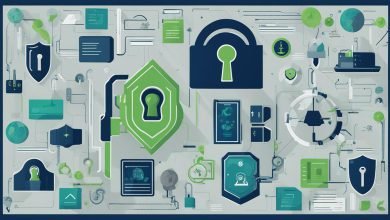
As technology continues to evolve rapidly, DevSecOps adoption has become an essential approach for organizations to stay competitive and secure. However, the process of implementing DevSecOps strategies can encounter significant resistance from stakeholders, including cultural resistance, lack of expertise, and integration issues.
Overcoming these challenges is crucial for organizations to drive successful DevSecOps adoption and gain a competitive edge. In this article, we will explore the key strategies and solutions to navigate and overcome such obstacles and foster a culture of collaboration and trust.
Key Takeaways
- Organizations encounter significant resistance when adopting DevSecOps strategies.
- Successful DevSecOps adoption requires navigating and overcoming cultural resistance, lack of expertise, and integration issues.
- Building a culture of collaboration and trust, effective training, leveraging automation and tooling solutions are crucial for DevSecOps adoption.
Understanding the DevSecOps Landscape
In today’s technology landscape, more and more companies are adopting DevSecOps strategies to improve collaboration, enhance security, and drive innovation. However, the adoption process can also be challenging, with various obstacles that organizations need to navigate to successfully implement DevSecOps practices.
DevSecOps adoption involves integrating security into the entire software development lifecycle, starting from the initial design phase and continuing through deployment and maintenance. While adopting DevSecOps practices can provide numerous benefits, such as improved efficiency, higher quality code, and enhanced security, it can also present challenges.
DevSecOps challenges often arise due to a lack of expertise, cultural resistance, and integration issues. Organizations need to overcome these challenges to effectively implement DevSecOps strategies and realize the full potential of this approach.
Adopting DevSecOps strategies requires a deep understanding of the DevSecOps landscape and the obstacles that may arise. Organizations must develop strategies to navigate these obstacles and foster a culture that values collaboration, trust, and continuous learning.
Fostering a Culture of Collaboration and Trust
One of the main challenges in DevSecOps adoption is overcoming resistance due to cultural differences and lack of trust between teams. It is essential to foster a culture of collaboration and trust to successfully implement DevSecOps practices.
Effective communication and collaboration between development, security, and operations teams are critical to the success of DevSecOps adoption. Organizations must create an environment that encourages open communication, mutual understanding, and respect for each other’s expertise. Building relationships based on trust and collaboration can help to overcome resistance and drive successful adoption.
Implementing Effective Training and Education Programs
Another significant barrier to DevSecOps adoption is a lack of expertise and understanding of DevSecOps practices. Organizations must provide training and education programs to upskill employees and ensure they have the necessary knowledge and tools to embrace DevSecOps practices.
Training programs should focus on providing employees with a deep understanding of DevSecOps principles, tools, and best practices. This can help to overcome resistance due to a lack of awareness or understanding and ensure that employees are fully equipped to implement DevSecOps strategies effectively.
Leveraging Automation and Tooling Solutions
Automation and tooling solutions are a critical component of DevSecOps adoption. They can help streamline processes, enhance security, and eliminate the manual effort required to implement DevSecOps practices.
While selecting the right tools is essential, it is equally important to implement them effectively. Organizations must ensure that they align with their specific needs and provide the desired results. Leveraging automation and tooling solutions can help to overcome resistance to DevSecOps adoption and drive successful implementation.
Building a Culture of Collaboration and Trust
A significant obstacle in adopting DevSecOps strategies is overcoming resistance from stakeholders. Resistance in technology adoption is common, particularly when it comes to changing processes and workflows. However, building a culture of collaboration and trust within the organization can help overcome these obstacles.
Effective communication is critical in fostering collaboration and trust. Teams must be willing to listen to each other and work towards a shared goal. Development, security, and operations teams should work together seamlessly to ensure that the adoption process goes smoothly.
Collaboration involves more than just communication; it also means establishing trust. Trust is built by showing that everyone has a stake in the process, and that all parties are equally committed to its success. When stakeholders feel that their concerns have been heard and addressed, they are more likely to embrace change.
To achieve a culture of collaboration and trust, organizations must be willing to invest time and resources in building relationships among teams. This may involve creating cross-functional teams, fostering a culture of innovation, and setting up training and education programs to ensure that everyone has the necessary knowledge and skills to support the adoption process.
Overcoming obstacles in DevSecOps requires a commitment to building a culture of collaboration and trust. By fostering effective communication, establishing trust, and investing in relationships among teams, organizations can overcome resistance and ensure the successful adoption of DevSecOps strategies.
Implementing Effective Training and Education Programs
In order to successfully navigate the challenges of adopting DevSecOps strategies, it is essential to build a culture of collaboration and trust, as outlined in the previous section. However, it is equally important to provide employees with the necessary training and education to understand and implement the practices effectively.
The challenges of adopting DevSecOps are multifaceted, and one of the most significant obstacles is the lack of expertise and knowledge in the field. Many organizations struggle to find employees with the necessary skills to embrace DevSecOps, and even those who have a basic understanding may struggle to implement the practices effectively.
To overcome these challenges, it is essential to invest in training and education programs that provide employees with the knowledge and tools they need to succeed. These programs should cover all aspects of DevSecOps, including development, security, and operations, and should be tailored to the needs of specific roles and departments.
A key aspect of these programs should be upskilling existing employees, as well as hiring individuals with the necessary expertise. This will ensure that all members of the organization are on the same page and have a shared understanding of the importance of DevSecOps.
One of the biggest challenges in implementing effective training and education programs is addressing the resistance that may arise due to a lack of awareness or understanding. To overcome this, it is essential to communicate the value of DevSecOps and why it is crucial for the organization’s success. This can be achieved through educational workshops, presentations, and other forms of communication.
“Education is the most powerful weapon which you can use to change the world.” – Nelson Mandela
Ultimately, implementing effective training and education programs is essential for overcoming the challenges of adopting DevSecOps. By upskilling employees and addressing any resistance that may arise, organizations can build a culture of collaboration and trust that will drive successful DevSecOps implementation.
Leveraging Automation and Tooling Solutions
One of the biggest obstacles to DevSecOps adoption is resistance from stakeholders. To navigate this, organizations must leverage automation and tooling solutions. By streamlining processes and enhancing security, stakeholders can be won over.
Automation solutions can not only reduce manual errors but also accelerate the pace of DevSecOps while improving compliance. It is important to select the right tools that address the specific needs of your organization. Implementing these tools effectively is equally important and requires collaboration between development, security, and operations teams.
One key aspect of tooling is continuous integration and continuous delivery (CI/CD) pipelines, which provide a streamlined framework for code development and deployment. It is important to ensure that these pipelines are well-documented and frequently updated to maintain their effectiveness.
Another essential tool for DevSecOps adoption is security testing automation, which can identify and address vulnerabilities early on in the development process. This includes everything from static code analysis to web application scanning and penetration testing. By investing in these tools, organizations can reduce the risk of security breaches and increase the pace of innovation.
Overall, automation and tooling solutions are critical to navigating resistance to DevSecOps adoption. By selecting the right tools and implementing them effectively, organizations can streamline processes, enhance security, and ultimately achieve successful adoption.
Conclusion
DevSecOps adoption comes with challenges, but overcoming resistance is crucial to stay competitive in the technology landscape. Fostering a culture of collaboration and trust within the organization, implementing effective training and education programs, and leveraging automation and tooling solutions are some of the strategies that can help navigate these challenges.
It is important to acknowledge that the journey to DevSecOps adoption may not be easy, but with the right approaches and mindset, it can be successful. Organizations that take the time and effort to implement these strategies will reap the rewards of enhanced security, faster time-to-market, and improved collaboration between development, security, and operations teams.
As technology continues to evolve, it is essential for organizations to embrace DevSecOps practices to stay ahead in the game. By implementing the strategies discussed in this article, organizations can overcome resistance and navigate the challenges of DevSecOps adoption to gain a competitive edge.
FAQ
Q: What are the main challenges faced when adopting DevSecOps strategies?
A: The main challenges faced when adopting DevSecOps strategies include cultural resistance, lack of expertise, and integration issues.
Q: Why is it important to overcome these challenges?
A: Overcoming these challenges is important for successful implementation of DevSecOps and for organizations to gain a competitive edge in today’s technology landscape.
Q: How can organizations foster a culture of collaboration and trust to overcome resistance to DevSecOps adoption?
A: Organizations can foster a culture of collaboration and trust by promoting effective communication, encouraging collaboration between development, security, and operations teams, and creating an environment of trust and mutual understanding.
Q: What is the significance of training and education programs in overcoming the challenges of adopting DevSecOps?
A: Training and education programs are significant in providing employees with the necessary knowledge and tools to embrace DevSecOps practices, addressing resistance due to lack of awareness or understanding.
Q: How can automation and tooling solutions help navigate resistance to DevSecOps?
A: Automation and tooling solutions can streamline processes, enhance security, and overcome resistance from stakeholders. Selecting the right tools and implementing them effectively is key to driving successful DevSecOps adoption.








